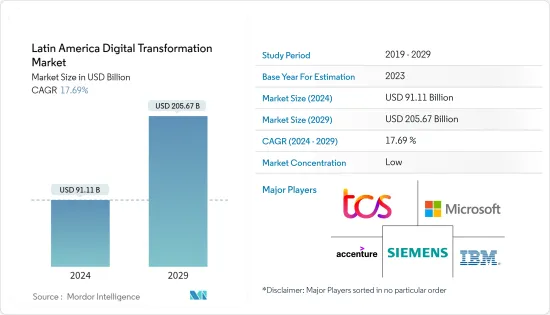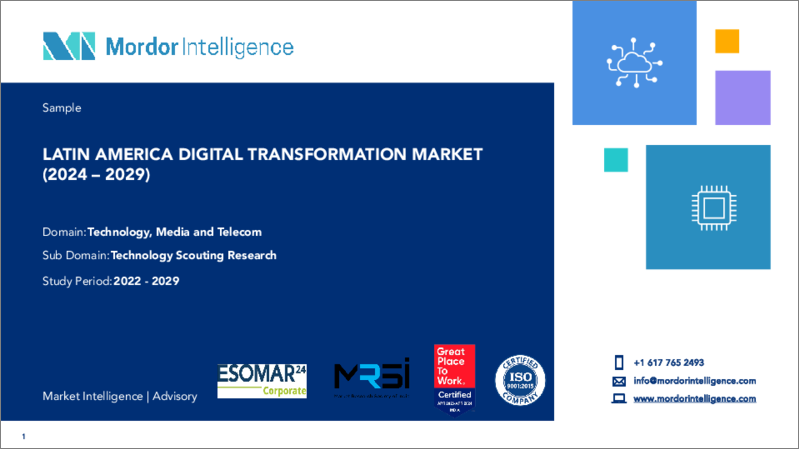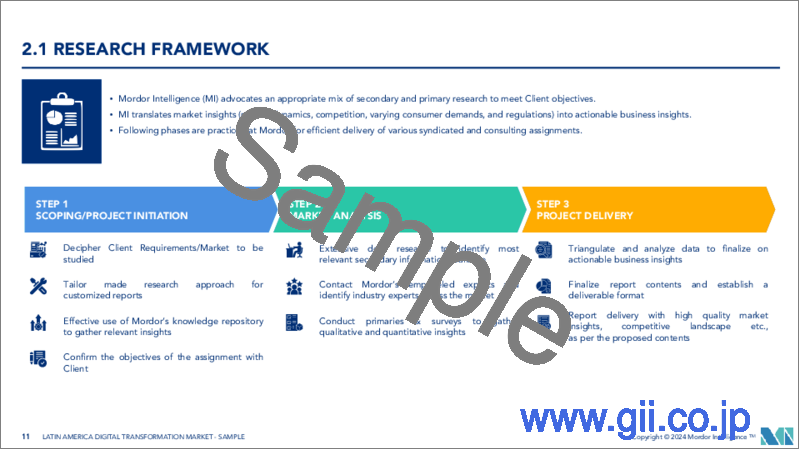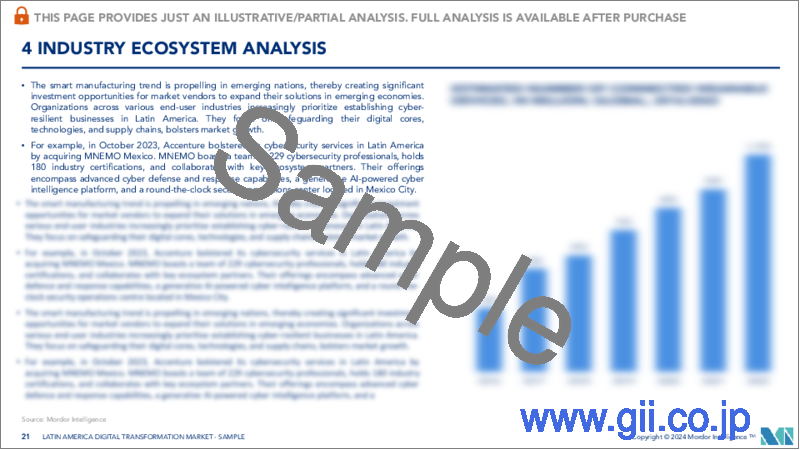|
|
市場調査レポート
商品コード
1550467
ラテンアメリカのデジタルトランスフォーメーション:市場シェア分析、産業動向、成長予測(2024年~2029年)Latin America Digital Transformation - Market Share Analysis, Industry Trends & Statistics, Growth Forecasts (2024 - 2029) |
||||||
カスタマイズ可能
適宜更新あり
|
|||||||
| ラテンアメリカのデジタルトランスフォーメーション:市場シェア分析、産業動向、成長予測(2024年~2029年) |
|
出版日: 2024年09月02日
発行: Mordor Intelligence
ページ情報: 英文 120 Pages
納期: 2~3営業日
|
全表示
- 概要
- 目次
ラテンアメリカのデジタルトランスフォーメーション市場規模は、2024年に911億1,000万米ドルと推定され、2029年には2,056億7,000万米ドルに達すると予測され、予測期間中(2024-2029年)のCAGRは17.69%で成長すると予測されます。

主なハイライト
- 製造業におけるインダストリー4.0のイントロダクションより、多くの工場がデジタル技術を導入し、プロセス全体の改善、自動化、アップグレードを図っています。ロボット化などのインダストリー4.0技術は、すでに多くの企業で一般化しています。例えば、2023年4月、インテリジェント・エッジの世界・ファシリテーターであるTelit Cinterion社は、工場自動化のためのプライベート5Gの概念実証試験の成功を発表しました。ネスレ・ブラジルと提携したこのトライアルは、製造業が5Gをインダストリー4.0変革戦略の基盤コンポーネントとするケースが増えている理由と方法を紹介しました。多くのメーカーが、プライベート5Gネットワークを含む5Gの導入を検討しているか、すでに導入しており、この世界の動向は2030年までに1,090億米ドルにのぼると見られています。
- IFRによると、ブラジルの自動車産業は産業用ロボットを最も多く導入しており、稼働中のロボットの47%、新規導入の22%を占めています。この能力により、自動車産業はロボットの最も重要なユーザーの1つとしての地位を維持し、世界で最も自動化されたサプライチェーンの1つとなっています。インテリジェント・ロボットは人間と一緒に働き、ほとんどの生産労働者が最も一般的で時間のかかる作業を実行し、適切に納品できるように訓練することができます。
- さらに、企業におけるIoTデバイスの使用の増加は、様々な業界におけるデジタルトランスフォーメーションを加速させると予測されています。GSMAによると、ラテンアメリカのモノのインターネット(IoT)接続数は、2025年までに12億まで増加すると予想されています。その頃には、IoTはこの地域で470億米ドル以上の収益を生み出すと予測されています。
- この地域では、ハイテク大手から中小企業まで、AIやディープラーニングの応用が拡大するにつれて、AIの専門技術者が不足しています。人材がいなければ、人工知能や機械学習へのこうした投資の増大が無駄になり、経済的損失や未実現の機会につながる可能性があります。
- しかし、デジタルトランスフォーメーションにおけるクラウド技術の採用には、データの保存とセキュリティに関する課題があります。組織は、クラウド・サービス・プロバイダーを慎重に評価し、暗号化技術を導入し、クラウドに保存された機密情報を保護するためのデータ・アクセス制御を確立する必要があります。例えば、ラテンアメリカと世界の最高法務責任者を対象に調査した「2024 General Counsel Report」では、回答者の43%が、リモートワークやハイブリッドワークの設定によってデータプライバシーリスクが影響を受けたと回答しています。
ラテンアメリカのデジタルトランスフォーメーション市場動向
IoTセグメントが最大の市場シェアを占める見込み
- 製造、自動車、ヘルスケアなどのエンドユーザー産業でIoT技術の採用が拡大していることが、市場の成長を積極的に後押ししています。伝統的な製造業がデジタル変革の渦中にある中、IoTはインテリジェントな接続性という次の産業革命に拍車をかけています。これにより、産業界はシステムや機械の複雑化するプロセスへの取り組み方を変え、効率の向上やダウンタイムの短縮を図っています。
- インダストリー4.0とIoTは、スマート・ファクトリー・オートメーションとして知られる、ロジスティクス・チェーン全体の開発、生産、管理のための新しい技術的アプローチの中心となっています。インダストリー4.0とIoTの受け入れによる製造業の大規模なシフトは、ロボティクスで人間労働を補完・拡張し、プロセスの失敗による産業事故を減らす技術で生産を進めるために、俊敏でよりスマートで革新的な方法を採用することを企業に要求しています。
- コネクテッド・デバイスやセンサーの採用率が高く、M2M通信が可能になったことで、製造業で生成されるデータ・ポイントが急増しています。これらのデータ・ポイントは、材料が1つのプロセス・サイクルを通過するのにかかる時間を表す指標から、自動車産業における材料応力能力の計算のような高度なものまで、様々な種類があります。
- フィールド・デバイス、センサー、ロボットの進歩は、市場範囲をさらに拡大すると予想されます。IoT技術は製造業の労働力不足を克服しつつあります。より多くの企業にとって、ロボット化のようなインダストリー4.0技術の利用は日常業務の一部となっています。
- ラテンアメリカのIoT需要動向は、今後数年間で消費者需要から産業分野へとシフトし、様々なインダストリー4.0アプリケーションが大量需要を牽引すると予想されます。需要の大部分は、製造業、エネルギー、ビジネス・モビリティ、ヘルスケア、サプライチェーンが牽引すると予想されます。
- さらに、スマートシティへの取り組みが、今後数年間のIoT成長の先鞭をつけると予想されます。IoTデバイスとシステムは、交通、公共事業、インフラの一部として増加すると予想されます。これに沿った政府の取り組みや推進策が採用率を押し上げると予想されます。さらに、産業オートメーションへの注力と技術の進歩が、産業オートメーションシステムの需要を煽り、ラテンアメリカの市場全体の成長を促進しています。
- 例えば、Master Certifications組織によると、産業のデジタル化の進展は経済に直接的な影響を与えます。モノのインターネット(Internet of Things)技術を導入することで、ブラジルは2030年までに2,100億米ドル以上の収益を生み出すと予想されています。作業環境とインフラを改善し、技術普及プログラムに投資することで、ブラジルはより高い経済水準に移行し、作業の生産性を向上させながら、設備の維持費やエネルギー消費費を削減することができます。
- さらに、メキシコ政府によると、メキシコは経済複雑性指数で上位10カ国に入る見込みで、2027年までにインダストリー4.0のイノベーターとしての地位を固める。メキシコの主要な製造工場は、継続的な成長が見込まれています。関係政府が特定の規制を合理化したことで、企業はほとんど問題なくメキシコで事業を立ち上げることができるようになった。
ブラジルが最も急成長する市場になる見込み
- この地域は、ブラジルの製造業経済によりファクトリーオートメーションが成長しています。
- ブラジルの強固な石油・ガスエコシステムは、市場成長にとって有利に働くと予想されます。例えば、エネルギー情報局(EIA)によると、2022年、ブラジルはラテンアメリカとカリブ海地域で最大の原油生産国で、平均生産量は日量300万バレルを超えました。
- ブラジルでは、8,500台以上のハイブリッド車や電気自動車が流通しています。国家電気エネルギー庁(Aneel)によると、電気自動車の数は2030年までに200万台に増加すると予想されています。ブラジルの産業用ロボットの導入台数は4,000台で、ブラジルで販売される産業用ロボットの約半分を自動車産業が占めています。
- 同国はまた、メーカーとしてもユーザーとしても、ロボットの利点を活用することが期待されています。IFRによると、ブラジルのロボット出荷台数は2018年から2020年にかけてCAGR 33%を記録する見込みです。
- 例えば、ABBは2023年2月、発電・水事業のデジタルトランスフォーメーションを支援する最新のABBアビリティ・シンフォニー・プラス分散型制御システム(DCS)のリリースを開始しました。総合プラントオートメーションで40年以上の経験を持つシンフォニー・プラスの最新バージョンは、コア制御とオートメーション機能に干渉することなく、エッジとクラウドへの簡素化された安全なOPC UA1接続を通じて、顧客のデジタルジャーニーをさらにサポートします。
- 製造業は、機械制御アーキテクチャを簡素化し、部品点数を最小限に抑え、製造時間を短縮し、生産性を最適化するスケーラブルなソリューションをますます求めています。ファクトリーオートメーションとICSの需要が市場で大幅に増加するにつれて、主要企業は主に技術革新とテクノロジーを駆使した新製品の開発に注力するようになった。
- 例えば、2023年7月、産業オートメーションとデジタルトランスフォーメーションに特化した著名な企業であるRockwell Automation, Inc.は、Kinetix 5700プラットフォームの拡張であるArmorKinetix Distributed Servo Drivesを発売し、よりスリムで環境に優しく、より強力な機械設計を実現するための拡張可能なドライブソリューションをユーザーに提供しました。また、スマートサーボドライブには、機械の潜在的な問題を検出できる振動センサと温度センサが搭載されており、問題を特定して対処し、システムの稼働時間をプロアクティブに増加させる能力を提供します。
ラテンアメリカのデジタル変革産業の概要
ラテンアメリカのデジタルトランスフォーメーション市場は断片化されており、アクセンチュアPLC、グーグルLLC(アルファベット社)、シーメンスAG、IBMコーポレーション、マイクロソフト・コーポレーションなどの企業が参入しています。同市場のプレーヤーは、製品提供を強化し、持続可能な競争優位性を獲得するために、提携、合併、技術革新、買収などの戦略を採用しています。
- 2024年5月インドのTelco SaaS企業であるAprecomm社は、ラテンアメリカ市場への進出に照準を合わせています。この動きを強化するため、アプレコムは地域の通信ソリューション・プロバイダーであるオープングローブと提携しました。この提携は、1億1,100万世帯以上の固定ブロードバンドを誇るラテンアメリカ市場を戦略的に狙ったものだった。オープングローブの通信サービス・プロバイダーや政府機関との強い結びつきを活用し、アプレコムの自己修復・自己最適化ネットワーク・ソリューションを通じて消費者体験を向上させる専門性を補完しました。
- 2024年4月ニューラ・ロボティクスとオムロンロボティクスアンドセーフティテクノロジーズは戦略的提携を発表。両社の目標は、コグニティブロボットをファクトリーオートメーションに統合することで、製造業を変革することです。これらのロボットはAIを活用し、効率性、柔軟性、安全性を高める。
その他の特典:
- エクセル形式の市場予測(ME)シート
- 3ヶ月間のアナリストサポート
目次
第1章 イントロダクション
- 調査の前提条件と市場定義
- 調査範囲
第2章 調査手法
第3章 エグゼクティブサマリー
第4章 産業エコシステム分析(デジタルトランスフォーメーション産業の主要利害関係者を詳細にカバー製品/ソリューションプロバイダー、システムインテグレーター/VAR、コネクティビティプロバイダー、規制機関、エンドユーザー、サービスプロバイダーなど)
第5章 市場力学
- 市場促進要因
- ラテンアメリカにおけるビッグデータ解析やその他のテクノロジーの採用増加
- モバイル機器とアプリの急速な普及
- 市場抑制要因
- 情報のプライバシーとセキュリティに対する懸念
第6章 現在の市場シナリオとデジタルトランスフォーメーションの進化
第7章 主要指標
- テクノロジー支出動向
- IoTデバイス数
- サイバー攻撃の総件数
- 技術スタッフの動向
- ラテンアメリカ諸国におけるインターネットの成長と普及
- デジタル競合ランキング
- 固定およびモバイルブロードバンド
- クラウドの採用
- AIの採用
- eコマースの普及率
第8章 市場セグメンテーション
- タイプ別
- アナリティクス、人工知能、機械学習
- 現在の市場シナリオと予測期間の市場予測
- 主な成長要因(促進要因、課題、機会)
- 使用事例分析
- 市場展望
- 拡張現実(XR)
- 現在の市場シナリオと予測期間の市場予測
- 主な成長インフルエンサー(促進要因、課題、機会)
- 使用事例分析
- 市場展望
- IoT
- 現在の市場シナリオと予測期間の市場予測
- 主な成長インフルエンサー(促進要因、課題、機会)
- 使用事例分析
- 市場展望
- 産業用ロボット
- 現在の市場シナリオと予測期間の市場予測
- 主要成長インフルエンサー(促進要因、課題、機会)
- 使用事例分析
- 市場展望
- ブロックチェーン
- 現在の市場シナリオと予測期間の市場予測
- 主な成長インフルエンサー(促進要因、課題、機会)
- 市場展望
- 積層造形/3Dプリンティング
- 現在の市場シナリオと予測期間の市場予測
- 主な成長インフルエンサー(促進要因、課題、成長機会)
- 使用事例分析
- 市場展望
- サイバーセキュリティ
- 現在の市場シナリオと予測期間の市場予測
- 主な成長要因(促進要因、課題、機会)
- 使用事例分析
- 市場展望
- クラウドコンピューティングとエッジコンピューティング
- 現在の市場シナリオと予測期間の市場予測
- 主な成長インフルエンサー(促進要因、課題、機会)
- 使用事例分析
- 市場展望
- その他(デジタルツイン、モビリティ、コネクティビティ)
- 現在の市場シナリオと予測期間の市場予測
- 主な成長インフルエンサー(促進要因、課題、機会)
- タイプ別市場内訳(デジタルツイン、モビリティ、コネクティビティ)
- 使用事例分析
- 市場展望
- アナリティクス、人工知能、機械学習
- エンドユーザー産業別
- 製造業
- 石油・ガス・公益事業
- 小売・eコマース
- 運輸・物流
- ヘルスケア
- BFSI
- 通信・IT
- 政府・公共部門
- その他(教育、メディア&エンターテイメント、環境など)
- 製造業
- 国別
- メキシコ
- ブラジル
- アルゼンチン
- その他ラテンアメリカ
第9章 競合情勢
- 企業プロファイル
- Accenture PLC
- Google LLC(Alphabet Inc.)
- Siemens AG
- IBM Corporation
- Microsoft Corporation
- Cognex Corporation
- Hewlett Packard Enterprise
- SAP SE
- EMC Corporation(Dell EMC)
- Oracle Corporation
- Adobe Inc.
- Amazon Web Services Inc.
- Apple Inc.
- Salesforce.com Inc.
- Cisco Systems Inc.
第10章 変革をもたらす主要技術
- 量子コンピューティング
- サービスとしての製造(MaaS)
- コグニティブ・プロセス・オートメーション
- ナノテクノロジー
The Latin America Digital Transformation Market size is estimated at USD 91.11 billion in 2024, and is expected to reach USD 205.67 billion by 2029, growing at a CAGR of 17.69% during the forecast period (2024-2029).

Key Highlights
- With the introduction of Industry 4.0 in the manufacturing sector, numerous factories are embracing digital technology to improve, automate, and upgrade the whole process. Industry 4.0 technology, such as robotization, is already commonplace in many enterprises. For example, in April 2023, Telit Cinterion, a global facilitator of the intelligent edge, announced the completion of a successful proof-of-concept trial of private 5G for factory automation. In partnership with Nestle Brazil, the trial showcased why and how manufacturers increasingly make 5G a foundational component of their Industry 4.0 transformation strategies. Many manufacturers are considering or already implementing 5G, including private 5G networks, a global trend that will be worth USD 109 billion by 2030.
- As per IFR, the Brazilian automotive industry is the foremost adopter of industrial robots, with 47% of operational robots and 22% of new installations recently. This capability enables the automotive industry to maintain its position as one of the most significant users of robots and possess one of the most automated supply chains globally. Intelligent robots work alongside humans and can be trained by most production workers to execute the most common, time-consuming jobs and deliver them properly.
- Furthermore, the increasing use of IoT devices in companies is predicted to accelerate digital transformation in various industries. According to GSMA, the number of Internet of Things (IoT) connections in Latin America was expected to increase up to 1.2 billion by 2025. By that time, IoT was projected to generate over USD 47 billion in revenue in the region.
- As AI and deep learning applications expand in the region, from tech giants to small and medium-sized businesses, there has been a shortage of expert AI technicians. Without talent, these increased investments in artificial intelligence and machine learning could be wasted, leading to financial losses and unrealized opportunities.
- However, the adoption of cloud technologies in digital transformation presents challenges related to data storage and security. Organizations need to carefully assess cloud service providers, implement encryption techniques, and establish data access controls to protect sensitive information stored in the cloud. For instnace, in the 2024 General Counsel Report, which surveyed chief legal officers in Latin America and globally, 43% of respondents indicated that their data privacy risks had been impacted by remote and hybrid work setups.
Latin America Digital Transformation Market Trends
The IoT Segment is Expected to Occupy the Largest Market Share
- The growing adoption of IoT technology across end-user industries, such as manufacturing, automotive, and healthcare, is positively driving the market's growth. With the traditional manufacturing sector amid a digital transformation, IoT is fueling the next industrial revolution of intelligent connectivity. This is changing how industries approach increasingly complex processes of systems and machines to improve efficiency and reduce downtime.
- Industry 4.0 and IoT are central to new technological approaches for developing, producing, and managing the entire logistics chain, otherwise known as smart factory automation. Massive shifts in manufacturing due to Industry 4.0 and the acceptance of IoT require enterprises to adopt agile, smarter, and innovative ways to advance production with technologies that complement and augment human labor with robotics and reduce industrial accidents caused by process failure.
- With the high rate of adoption of connected devices and sensors and the enabling of M2M communication, there has been a surge in data points generated in the manufacturing industry. These data points can be of various kinds, ranging from a metric describing the time taken for the material to pass through one process cycle to a more advanced one, such as calculating the material stress capability in the automotive industry.
- The advancements in field devices, sensors, and robots are expected to expand the market scope further. IoT technologies are overcoming the labor shortage in the manufacturing sector. For more and more organizations, using Industry 4.0 technologies, like robotization, is part of day-to-day operations.
- The IoT demand trend in the Latin America is expected to shift toward the industrial space from consumer demand over the coming years, with sheer volume demand driven by various Industry 4.0 applications. A significant share of the demand is expected to drive the manufacturing industries, energy, business mobility, healthcare, and supply chain.
- Moreover, smart city initiatives are expected to spearhead IoT growth over the coming years. IoT devices and systems are expected to increase as part of transportation, utilities, and infrastructure. Government initiatives and drives in line with this are expected to boost the adoption rates. Additionally, focus on industrial automation and technological advancements fuel the demand for Industrial automation systems, driving the overall growth of the market in Latin America.
- For instance, according to the Master Certifications organization, the progress of industry digitalization has a direct impact on the economy. By deploying Internet of Things technologies, Brazil is expected to create more than USD 210 billion in revenues by 2030. By improving work environments and infrastructure and investing in technological dissemination programs, Brazil will be able to move to a higher economic level and lower equipment maintenance and energy consumption expenses while enhancing work productivity.
- Moreover, according to the Mexican government, Mexico is expected to be among the top 10 countries in the Economic Complexity Index, cementing its place as an innovator in Industry 4.0 by 2027. The major manufacturing factories in Mexico are expected to see continual growth. The involved governments have streamlined specific regulations, which have allowed businesses to establish operations in Mexico with little difficulty.
Brazil is Expected to be the Fastest Growing Market
- The region is experiencing growth in factory automation owing to Brazil's manufacturing economy, which gives rise to automation and is primed for inward industrial investment.
- The robust oil and gas ecosystem in Brazil is anticipated to be lucrative for the market's growth. For instance, according to the Energy Information Administration (EIA), in 2022, Brazil was the largest crude oil-producing country in Latin America and the Caribbean, with an average output of over three million barrels per day.
- In Brazil, over 8,500 hybrid and electric vehicles are in circulation. According to the National Agency of Electric Energy (Aneel), the number of electric vehicles is expected to rise to 2 million by the year 2030. Brazil had an installed base of 4,000 industrial robots, and in that the automotive industry accounted for approximately half of the industrial robots sold in Brazil.
- The country is also expected to leverage the benefits of robotics both as a manufacturer and a user. According to IFR, robotics shipments in Brazil are expected to witness a CAGR of 33% between 2018 and 2020.
- For instance, in February 2023, ABB launched its latest ABB Ability Symphony Plus distributed control system (DCS) release to support digital transformation for power generation and water enterprises. With more than 40 years of experience in total plant automation, the latest version of Symphony Plus will further support customers' digital journey through a simplified and secure OPC UA1 connection to the Edge and Cloud without interfering with core control and automation functionalities.
- Manufacturers are increasingly seeking scalable solutions that simplify their machine control architectures, minimize the number of components, reduce manufacturing time, and optimize productivity. As the demand for factory automation and ICS increases significantly in the market, it has led key players to focus primarily on innovating and developing new products with innovations and technologies.
- For instance, in July 2023, Rockwell Automation, Inc., a prominent company dedicated to industrial automation and digital transformation, launched ArmorKinetix Distributed Servo Drives, an extension of the Kinetix 5700 platform and provides users with a scalable drive solution that helps them deliver leaner, greener, and more powerful machine designs. The smart servo drives also include vibration and thermal sensors that can detect potential machine issues, offering the ability to identify and address problems and increase system uptime proactively.
Latin America Digital Transformation Industry Overview
The Latin American digital Transformation Market is fragmented, with players like Accenture PLC, Google LLC (Alphabet Inc.), Siemens AG, IBM Corporation, and Microsoft Corporation. Players in the market are adopting strategies such as partnerships, mergers, innovations, and acquisitions to enhance their product offerings and gain sustainable competitive advantage.
- May 2024: Aprecomm, an Indian Telco SaaS company, set its sights on expansion into the Latin American market. To bolster this move, Aprecomm partnered with OpenGlobe, a regional telecommunications solutions provider. The collaboration was strategically aimed at the Latin American market, which boasted over 111 million fixed broadband households. It leveraged OpenGlobe's strong ties with communication service providers and governmental entities, complemented by Aprecomm's specialization in elevating consumer experiences through self-healing and self-optimizing network solutions.
- April 2024 : Neura Robotics and OMRON Robotics and Safety Technologies Inc. announced a strategic partnership. Their goal was to transform the manufacturing landscape by integrating cognitive robots into factory automation. These robots harness AI to boost efficiency, flexibility, and safety.
Additional Benefits:
- The market estimate (ME) sheet in Excel format
- 3 months of analyst support
TABLE OF CONTENTS
1 INTRODUCTION
- 1.1 Study Assumptions and Market Definition
- 1.2 Scope of the Study
2 RESEARCH METHODOLOGY
3 EXECUTIVE SUMMARY
4 INDUSTRY ECOSYSTEM ANALYSIS (Detailed Coverage of Key Stakeholders in Digital Transformation Industry Product/Solution Providers, System Integrators/VARs, Connectivity Providers, Regulatory Bodies, End-users, Service Providers, etc.)
5 MARKET DYNAMICS
- 5.1 Market Drivers
- 5.1.1 Increase in the adoption of big data analytics and other technologies in Latin America
- 5.1.2 The rapid proliferation of mobile devices and apps
- 5.2 Market Restraints
- 5.2.1 Concerns about the Privacy and Security of Information
6 CURRENT MARKET SCENARIO AND EVOLUTION OF DIGITAL TRANSFORMATION PRACTICES
7 KEY METRICS
- 7.1 Technology Spending Trends
- 7.2 Number of IoT Devices
- 7.3 Total Cyberattacks
- 7.4 Technology Staffing Trends
- 7.5 Internet growth and penetration in Latin American Countries
- 7.6 Digital Competitiveness Ranking
- 7.7 fixed and mobile broadband cove
- 7.8 Cloud adoption
- 7.9 AI adoption
- 7.10 E-commerce penetration
8 8. MARKET SEGMENTATION
- 8.1 By Type
- 8.1.1 Analytics, Artificial Intelligence and Machine Learning
- 8.1.1.1 Current Market Scenario and Market Projections for the Forecast Period
- 8.1.1.2 Key Growth Influencers (Drivers, Challenges, and Opportunities)
- 8.1.1.3 Use Case Analysis
- 8.1.1.4 Market Outlook
- 8.1.2 Extended Reality (XR)
- 8.1.2.1 Current Market Scenario and Market Projections for the Forecast Period
- 8.1.2.2 Key Growth Influencers (Drivers, Challenges, and Opportunities)
- 8.1.2.3 Use Case Analysis
- 8.1.2.4 Market Outlook
- 8.1.3 IoT
- 8.1.3.1 Current Market Scenario and Market Projections for the Forecast Period
- 8.1.3.2 Key Growth Influencers (Drivers, Challenges, and Opportunities)
- 8.1.3.3 Use Case Analysis
- 8.1.3.4 Market Outlook
- 8.1.4 Industrial Robotics
- 8.1.4.1 Current Market Scenario and Market Projections for the Forecast Period
- 8.1.4.2 Key Growth Influencers (Drivers, Challenges, and Opportunities)
- 8.1.4.3 Use Case Analysis
- 8.1.4.4 Market Outlook
- 8.1.5 Blockchain
- 8.1.5.1 Current Market Scenario and Market Projections for the Forecast Period
- 8.1.5.2 Key Growth Influencers (Drivers, Challenges, and Opportunities)
- 8.1.5.3 Market Outlook
- 8.1.6 Additive Manufacturing/3D Printing
- 8.1.6.1 Current Market Scenario and Market Projections for the Forecast Period
- 8.1.6.2 Key Growth Influencers (Drivers, Challenges, and Opportunities)
- 8.1.6.3 Use Case Analysis
- 8.1.6.4 Market Outlook
- 8.1.7 Cybersecurity
- 8.1.7.1 Current Market Scenario and Market Projections for the Forecast Period
- 8.1.7.2 Key Growth Influencers (Drivers, Challenges, and Opportunities)
- 8.1.7.3 Use Case Analysis
- 8.1.7.4 Market Outlook
- 8.1.8 Cloud and Edge Computing
- 8.1.8.1 Current Market Scenario and Market Projections for the Forecast Period
- 8.1.8.2 Key Growth Influencers (Drivers, Challenges, and Opportunities)
- 8.1.8.3 Use Case Analysis
- 8.1.8.4 Market Outlook
- 8.1.9 Others (digital twin, mobility and connectivity)
- 8.1.9.1 Current Market Scenario and Market Projections for the Forecast Period
- 8.1.9.2 Key Growth Influencers (Drivers, Challenges, and Opportunities)
- 8.1.9.3 Market Breakdown by Type (Digital Twin, Mobility and Connectivity)
- 8.1.9.4 Use Case Analysis
- 8.1.9.5 Market Outlook
- 8.1.1 Analytics, Artificial Intelligence and Machine Learning
- 8.2 By End-User Industry
- 8.2.1 Manufacturing
- 8.2.1.1 Oil, Gas and Utilities
- 8.2.1.2 Retail & e-commerce
- 8.2.1.3 Transportation and Logistics
- 8.2.1.4 Healthcare
- 8.2.1.5 BFSI
- 8.2.1.6 Telecom and IT
- 8.2.1.7 Government and Public Sector
- 8.2.1.8 Others (Education, Media & Entertainment, Environment etc)
- 8.2.1 Manufacturing
- 8.3 By Country
- 8.3.1 Mexico
- 8.3.2 Brazil
- 8.3.3 Argentina
- 8.3.4 Rest of Latin America
9 COMPETITIVE LANDSCAPE
- 9.1 Company Profiles
- 9.1.1 Accenture PLC
- 9.1.2 Google LLC (Alphabet Inc.)
- 9.1.3 Siemens AG
- 9.1.4 IBM Corporation
- 9.1.5 Microsoft Corporation
- 9.1.6 Cognex Corporation
- 9.1.7 Hewlett Packard Enterprise
- 9.1.8 SAP SE
- 9.1.9 EMC Corporation (Dell EMC)
- 9.1.10 Oracle Corporation
- 9.1.11 Adobe Inc.
- 9.1.12 Amazon Web Services Inc.
- 9.1.13 Apple Inc.
- 9.1.14 Salesforce.com Inc.
- 9.1.15 Cisco Systems Inc.
10 KEY TRANSFORMATIVE TECHNOLOGIES
- 10.1 Quantum Computing
- 10.2 Manufacturing as a Service (MaaS)
- 10.3 Cognitive Process Automation
- 10.4 Nanotechnology





